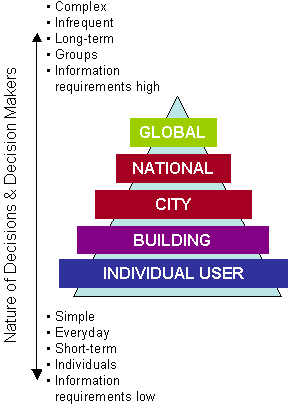
| Hari Srinivas | |
| Policy Analysis Series E-003. April 2015 |
The objective of the decision-making pyramid is to illustrate that 'simple' decisions and choices taken by individuals on a daily basis cumulatively have a global impact, and how vice versa, we need to break down global decisions into smaller frequent sustainability choices at the individual level.A simple example of this process is to breakup a 'global' environmental problem such as desertification into individual causes (deforestation, water extraction, agricultural practices) and then further to choices and decisions that that influences these causes (lifestyle choices, consumption patterns, technology development etc.), ending up with one option that can be taken up at the local and individual level, for example, choice of the foods we eat.
The pyramid has the individual level at the bottom level, and the global level at the top. In between are aligned other levels of decision-making: a community, city, and national.
While the bottom reflects simple decisions taken everyday, the top represents complex decisions taken more infrequently. Activities at the local/micro level influences the global level; activities at the global level influences the local/micro level.
The pyramid is actually a continuum: as we go from the bottom to the top, we see that -
- individual decisions are replaced by decisions taken by groups, the largest (i.e. everyone) at the topmost
- decisions become more complex covering a broader range of different aspects
- quality and quantity information required for decision-making increases
- short-term decisions are replaced by longer-term decisions.
The link between the top and the bottom of the sections of the pyramid is in fact cyclical: the everyday choices and preferences at the bottom of the pyramid influences policies developed at the global level.
On the other hand, decisions and agreements made at the global level clearly influences action at the bottom of the pyramid. For example, the Montreal Protocol on ozone depletion at the global level and product choices at the local level.
Thus, outputs generated at the top of the pyramid - the global level - are policy oriented and have indirect impacts on everyday life, while outputs generated at the bottom of the pyramid - the individual level - are action-oriented and have direct impacts on everyday life.
What happens when we apply this decision-making pyramid to the building and construction sector? How can we break down a decision that needs complex long-term multi-stakeholder involvement, into smaller frequent individual decisions to be taken at the micro level on a daily basis?
In the example here, we start with a global goal: "CO2 levels need to be reduced" We then see how this global goal impacts other levels and generates action, initiated and carried out by multi-stakeholder partnerships.
LEVEL: Global Actions and implications at this level: At the global level, much attention is paid to trends in CO2 concentration, how trans-national trade and other globalisation processes are increasing CO2 concentration, and build scenarios on what will be the long-term impact of CO2 concentration. Causes and effects are also outlined, with targets and plans of action for national governments. Stakeholders involved: UN and international organizations, universities and research institutions, international NGOs. LEVEL: National Actions and implications at this level: The commitment that national governments make at global/UN forums to 'reduce CO2 levels' is converted into national policies and programmes where support and guidance, in the form of rules, regulations legislation, research and development, financial support etc. is outlined and implemented. Stakeholders involved: National government ministries, agencies and departments; research and training institutions; universities; business and industry associations; chambers of commerce LEVEL: City Actions and implications at this level: Cities and local governments take advantage of the special arrangements made at the national level to implement it locally, by integrating the goals and objectives within their own environmental management plans. Local ordinances, regulations, etc. are combined with information campaigns and other means of informing the local communities of the need to reduce CO2 levels in the city. Campaigns can include special subsidies for developers, transportation planning, guidelines and checklists etc. Many cities have now kept such CO2 reduction goals at the center of their plans for an urban environmental management system based on ISO14001. Stakeholders involved: local government agencies and departments, business and industry associations, local chambers of commerce, financial institutions, NGOs and community groups, local universities and research institutions etc. LEVEL: Building Actions and implications at this level: This is the critical step where the guidelines, checklists, and regulations are converted to planning and design specifications that help in reduced CO2 emissions from buildings, and the activities that are undertaken within them. Material specifications, design features, technology choices, and building usage procedures have a key role to play in achieving reducing CO2 levels. Stakeholders involved: Individual users, clubs and NGOs, management teams LEVEL: Individual Actions and implications at this level: Much of the action at this level concerns the day-to-day use of the building. It is these activities that cumulatively have a substantial impact on the environment, and provide the most critical opportunity for action. Reducing electricity usage, minimizing the amount of water used and wastes generated, espousing the 3Rs - reduce/reuse/recycle are some of the actions taken at this level. These can follow strict procedures laid out by the management or can be self-persuasion through education and awareness-building. Stakeholders involved: Individual users, clubs and NGOs, management teams The key message of the decision pyramid is clear - (1) We need to ensure that global goals and objectives are translated to viable local actions that cumulatively help achieve the objectives. (2) Appropriate stakeholders should be involved at the right level, and partner with each other for the purpose of taking the right action at that level; (3) proper communication among stakeholders - between levels and within a particular level is very important.
|
on |
| Environmental Decision-Making Contact:
|

